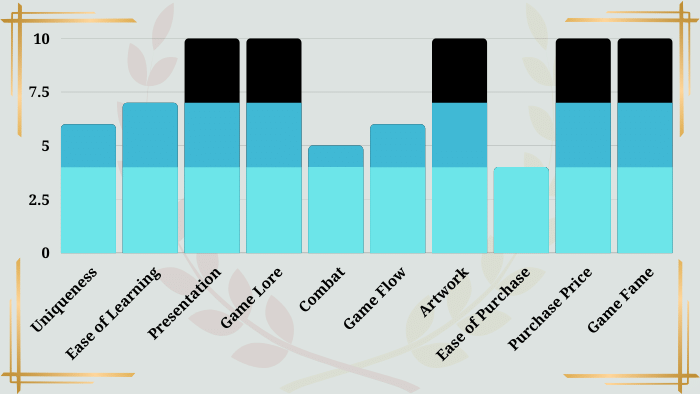Home > TTRPG Reviews
Star Wars Tabletop RPG PDF Review
This Star Wars tabletop RPG PDF review is part of my “Best Tabletop RPGs of All Time” article. If you want to check out more TTRPGs and see how other top-tier tabletop RPGs are ranked, visit that page.
My Review – 78 / 100

Just to get everyone on the same page, when I say that this is a Star Wars tabletop RPG PDF review, what I’m talking about this version of the game: Star Wars Roleplaying Game: Revised, Expanded, Updated.
One of the first things to note about Star Wars when it comes to its tabletop RPGs is that there are a lot of them, and they are all slightly different. This can create quite a bit of confusion for groups looking to get into this particular game.
If you do want to play Star Wars, I recommend the version I just mentioned immediately above. It’s easy to find, enjoyable, balanced, and has high production value.
Uniqueness of the Game: (6/10)
Star Wars as a franchise is unique in and of itself, so the tabletop RPG gets extra points just for being Star Wars.
I love all the force powers in Star Wars. If you play a Jedi, you get access to everything that’s cool about the game. Honestly, I can’t imagine why anyone wouldn’t play a Jedi, unless you’ve already played a Jedi so many times that you’re sick of it already.
Without all of the Jedi powers, this game becomes something very basic. “Equip gear, have stats, roll dice.” Jedi powers have all the “magic” of the game, which leads me to the conclusion that Jedi really “are the game.” Take them away, and you take away almost everything that’s unique about the game.
This RPG does feature “Wild Dice,” which is interesting. The Wild Dice creates additional complications to the story when you roll a “1” and allows you to roll again when you roll a “6,” meaning that, in theory, anything can happen.
Ease of Learning Star Wars RPG: (7/10)
Character creation in Star Wars tabletop RPG is neither easy nor extremely difficult compared to other TTRPGs.
But let me emphasize that it’s not easy. Usually, you need someone who understands the game to walk you through. Otherwise, you’ll spend hours (at least 1-2 hours if you’re new to tabletop RPGs) just creating your character.
Character creation is usually when tabletop RPG campaigns fall apart. With some games, it takes so long to create a character that people get overwhelmed, intimidated, and never show up for the first actual gaming session. Because of the time it can take to create a character from scratch, Star Wars RPG is in real danger of collapsing entire RPG campaigns before the actual game ever begins. There’s a high level of entry just to get started.
The saving grace is that we’re talking about Star Wars, here. Some people love Star Wars enough that no rulebook can ever push them away from playing their Jedi (or other types of characters, I suppose).
If you’re dedicated enough to playing a campaign, there’s no reason that character building should intimidate you away from playing this game.
Eternity TTRPG Top Sellers
Star Wars RPG Presentation: (10/10)
The Star Wars rulebook is very high quality. The artwork, graphics, font, colors, and helpful tables located throughout the book create a great experience.
In every section of the rulebook there are also loads of examples that help illustrate the rules. I like the extra examples as they help new players. Also… I hate the extra examples because there are a lot of them, and they are sometimes pages long.
However, the way these examples are done throughout the book does make the game more accessible, so it’s an overall plus. The in-depth examples (for example) leave little doubt as to how the game is supposed to be played.
Star Wars Lore: (10/10)
The game’s designers nailed everything in this book from Jedi force powers to space travel, and even in-depth ship details. Star Wars fans of all kinds will be thrilled to play this game. From everything I can tell, the game is 100% in line with Star Wars canon, and represents all the great parts of the Star Wars universe extremely well.
Combat in Star Wars RPG: (5/10)
The combat I’ve experienced in Star Wars is reasonably fun, but fights often take 45 minutes or more, each. Usually, within a few minutes or so, you can see advantages start to accrue on one side or another. Once those advantages accrue, you more or less know what the end result is going to be., it just then takes forever for that end result to actually happen.
I don’t mind this game’s combat system. I just think it’s a little slow-paced. There’s a lot of dice rolling, adding up results, and comparing tables, etc. Basically, there’s a lot of things that are “related to combat,” but in my mind, aren’t really “combat,” itself. I usually enjoy games where combat makes me feel like something is happening and I need to pay close attention to make sure my character survives.
There also aren’t really any unique systems to combat in Star Wars, surprisingly. You essentially just aim, attack, roll, and then see what happens. Even as a Jedi, aside from your force powers (of which you may not have many) you only have a few lightsaber techniques to use.
Fights are a little anticlimactic because everything comes down to rolls. When gaming, I didn’t ever feel like my tactical decisions mattered very much when it came to combat.
Game “Flow”: (6/10)
The game flow for Star Wars RPG is amazing in some ways and bad in others:
- From a lore perspective, the game flow is flawless.
- From a skill check perspective, the game is reasonably fast, featuring simple resolutions.
- In combat, there is no such things as “game flow.” Instead, things get a little boring after the first 10 minutes of each fight, in many cases.
Star Wars Artwork: (10/10)
Incredible. The Star Wars RPG art puts you into the game’s world. Honestly, this is some of the best art you can find anywhere. I like the quality of art in this game as much as I like the art in Dungeons and Dragons, which is saying a lot. There are top-quality artists, here.
The book has lots of artwork throughout, and the art style/ theme is also very consistent from start to finish.
Ease of Purchase: (4/10)
When I said earlier that there are many versions of the Star Wars tabletop RPG, it really is not clear at all which game you should play. Or, which game you should purchase.
There are so many versions of Star Wars RPG that it’s sort of a problem. Many of the games are also out-of-date or out-of-print, which adds to the confusion.
Furthermore, there are different games for different time periods in the Star Wars universe and for different types of play: Jedi vs. Sith, Rebellions, Han Solo type characters, etc. To find the right game you literally have to do research to figure out the most recent rules for the game, and for which style of game you and your friends want to play.
This score is only as high as it is because these books still sell on Amazon. Since you can get all of the Star Wars RPG options through a search on Amazon, you can simply find a book which you like the look of most, and go from there. Alternatively, I recommend looking for the “Star Wars Roleplaying Game: Revised, Expanded, Updated” and sharing that same game with your gaming group to make sure you all purchase the same version.
Price & How Many Books Do You Need to Play: (10/10)
You just need one book – the core rulebook – to play. These books also have a good price to them, or can be found as PDFs, online.
Fame & Availability of Supplemental Material: (10/10)
It’s Star Wars. Need I say more? Easily, everything you need to play a full campaign is already provided for you.
Star Wars Roleplaying Game: Revised, Expanded, Updated is Produced By












